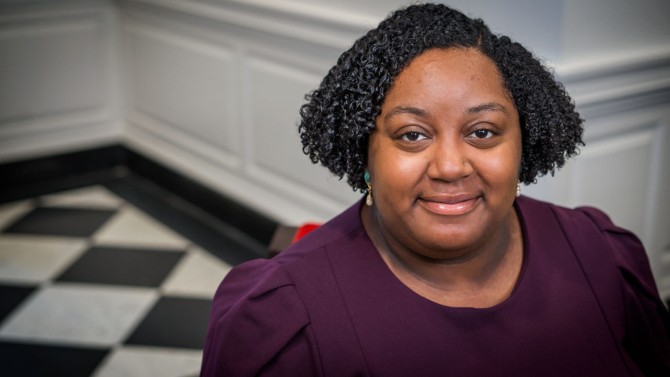How to create safe spaces with and for Black girls
By Caitlin Hayes, Cornell Chronicle
In 2018, as a graduate student, Assistant Professor Misha Inniss-Thompson ’16 worked alongside four Black girls and colleagues at Vanderbilt University to co-found the Black Girl Magic Crew, an afterschool program for Black adolescent girls aimed at supporting and celebrating their talents, identity development and wellness. As the community coalesced, Inniss-Thompson and her collaborators documented the program’s impacts.
They found that the program provided girls with something they often lacked in other spaces: psychological safety.
Now, a study based on interviews with group participants, published Feb. 4 in the Journal of Black Psychology, specifically describes how spaces created with and for Black girls can offer them psychological safety and allow them to be their authentic, open and direct selves: by validating their experiences, emotions and self-definition.
The study provides educators, mental health practitioners and youth-serving organizations with a blueprint for working with Black girls to create spaces, in and out of school, where Black girls feel seen, heard and honored.
“We need to cultivate relationships with our students that are humanizing,” said Inniss-Thompson, assistant professor of psychology in the College of Human Ecology and lead author of the study. “Given the violence and stereotypes that are commonplace for Black girls, it’s really important to think about what it looks like to engage in practices that are culturally affirming and that honor the multidimensional nature of Black girls’ experiences.”
Co-authors of the study include Seanna Leath at Washington University in St. Louis and Jamelia N. Harris at Justice + Joy National Collaborative.
The need for and importance of Black girl spaces in schools is well-documented, said Inniss-Thompson, whose broader research program examines how families, communities and schools shape Black girls’ mental health and wellness. The authors cite research documenting Black girls’ experiences with what scholars have identified as anti-Black girl violence, including being less likely to be listened to when reporting harassment, more frequently policed for dress code violations or tone of voice, and disproportionately suspended and criminalized within schools.
In interviews with 16 girls who participated in the Black Girl Magic Crew, all from a single high school in the southeastern U.S., researchers found that, when asked to describe the program, the girls consistently and without prompting used the word “safe.” That guided the researchers to study how the ethos and curricular elements in the program enabled the girls to feel comfortable in the space.
The team found that providing the girls space to share their experiences and emotions, both positive and negative, and the space to define themselves on their own terms helped them to challenge negative stereotypes they felt subjected to and oppressed by in their daily lives. Sharing their experiences and defining themselves on their own terms constituted a form of resistance and agency, the researchers said.
“Black girls have had to hide their Black girlness or change their Black girlness to fit other people’s definitions of a girl, or what it is to be Black, or what it is even to be themselves in society,” said a 16-year-old participant who described herself as creative. “So, I feel like it’s important to have a crew like this, to have us connect and share our experiences with each other about our Black girlness.”
“Once we can acknowledge as a group that anti-Black girl violence exists,” Inniss-Thompson said, “we can then work alongside Black girls to create spaces that feel safe, where they can build relationships with their peers, with adults, where they can be free to express themselves and heal through the traumas but also celebrate the exciting parts of their lives.”
The authors offered specific curricular activities that validated participants’ experiences and opinions and encouraged self-exploration. The activities include engaging participants in the co-creation of community norms; inviting participants at each session to share a positive experience (a rose) and a negative one (a thorn); centering Black girls’ experiences by asking them to bring in samples of songs, shows, movies or social media posts that resonate with them; discussing stereotypes of Black girls and how the participants would like to be understood and seen; and interacting with books, films and art about Black lives that prompt feelings they are then able to process as a group.
Co-creating spaces with and for Black girls is essential, the authors write, because the process can teach them how to build and create spaces for themselves as they transition into adolescence and early adulthood. Creating space alongside Black girls also allowed the program facilitators, all Black women, to share their own experiences, which made it easier for the girls to share and helped build intergenerational relationships.
Inniss-Thompson hopes practitioners can use the Black Girl Magic Crew curriculum as a model and the impacts of the program as justification for creating these spaces – especially in the midst of pushback on racially diverse books and historically accurate curricula across the U.S. She also hopes it will spur more research.
“The field of psychology can think more about the ways Black girls are creating spaces where they socialize themselves alongside Black women, where they are learning what it means to be a Black girl in this country,” Inniss-Thompson said. “I think there’s still a lot of room to think about not only the systemic issues Black girls face, but also what’s working well and how we amplify that, too.”
Media Contact
Get Cornell news delivered right to your inbox.
Subscribe

